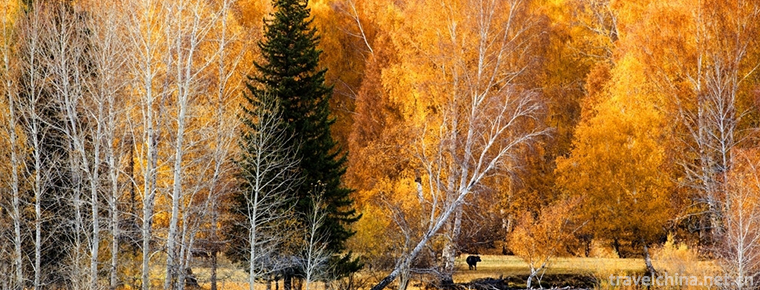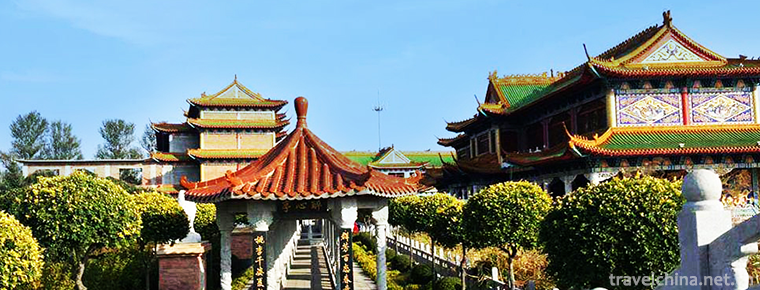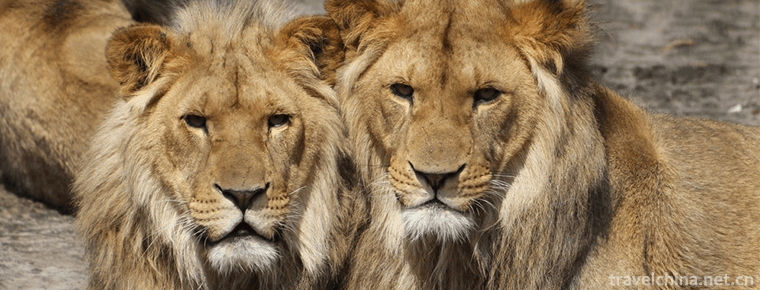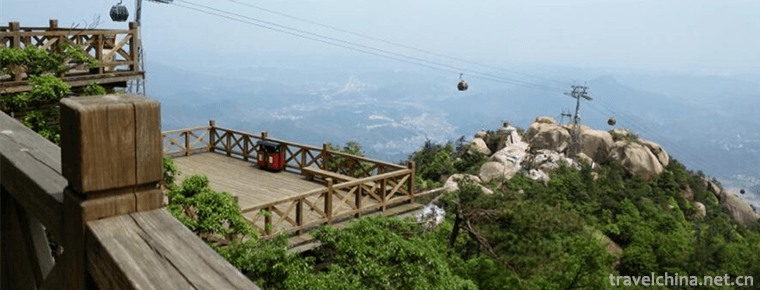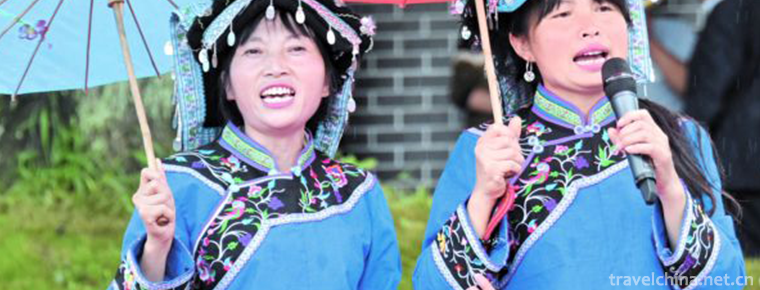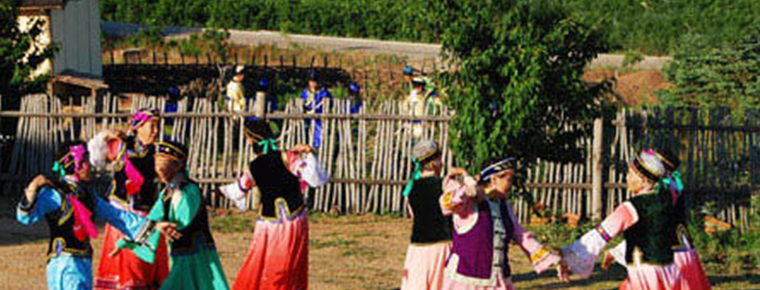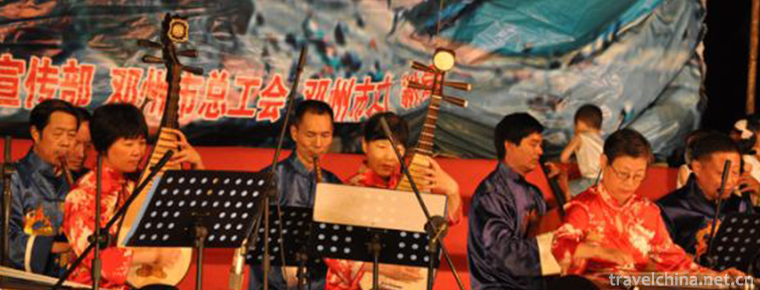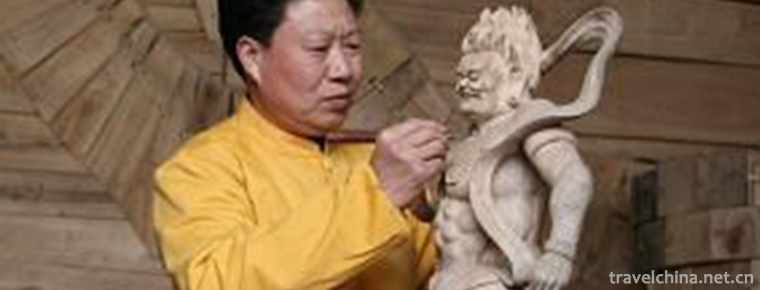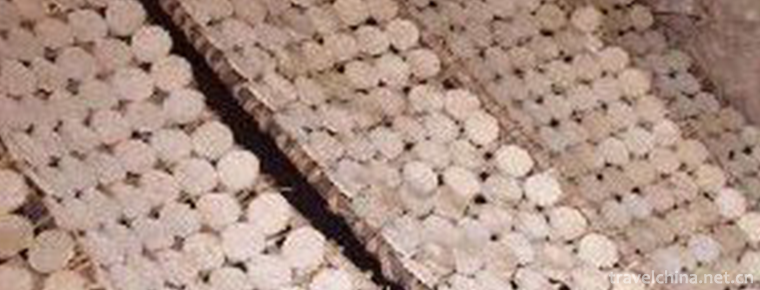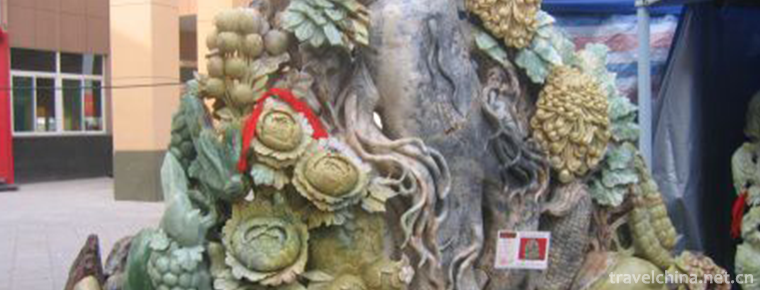Production Techniques of Dahongpao of Wuyi Rock Tea
Production Techniques of Dahongpao of Wuyi Rock Tea
Wuyi Rock Tea (Dahongpao) production technology, local traditional handicraft in Wuyishan City, Fujian Province, one of the national intangible cultural heritage.
Wuyi Rock Tea (Dahongpao) unique "rock bone flower fragrance" is created by Wuyi Mountain's special ecological environment, climate conditions and exquisite traditional production techniques. Its traditional production process has 10 processes, interlocking and indispensable. Among them, the key roles for tea quality are "compound withering", "seeing green as green, seeing green as big as green", "going back to the sun" and "double-stir-frying and double-kneading". "Low temperature and long drying" and other links.
On May 20, 2006, Wuyi Rock Tea (Dahongpao) production technology was approved by the State Council of the People's Republic of China and listed in the first batch of national intangible cultural heritage list, project number: _-63.
historical origin
There were legends about tea making in Han Dynasty. More than 2000 years ago, Emperor Wudi of Han Dynasty "offered sacrifices to Emperor Wuyi and used dried fish" (Records of History and the Book of Fengchan). After receiving tribute to Wuyi Tea from officials, he was highly appreciated. Su Dongpo, a great poet of the Song Dynasty, wrote the biography of Ye Jia and personified Wuyi tea as Ye Jia.
Tang Dynasty has seen tea making and drinking poetry. In Tang Dynasty, Wuyi Mountain was named "famous mountains and rivers" by the court, and Wuyi tea was also regarded as a treasure. Sun Qiao (825 - 885), a foreign official, personified Wuyi tea as "late greeting" in the Ministry of Tea Delivery and Jiao Penalty. In 894, the poetry Xie Shangshu Huiwax noodle tea written by Jinshi and Xu Bi, the Secretary of the provincial government, said, "Wuyi Spring is full at the beginning of the warm moon, picking new buds and offering immortals to the earth." The flying pigeons are printed into fragrant wax sheets, and the simian streams follow the Mulan boats..." It also mentions the origin, sacrifice, production, transportation, boiling and drinking.
Song Dynasty made delicate Longtuan Fengcai tea. In the Song Dynasty, literati and poets who lived in seclusion and traveled to Wuyi Mountain flourished. At that time, Wuyi Tea was famous as Rilong Tuan Fengcai Tea. Its production process was very exquisite: picking abstracts such as Eagle claws, picking out impurities after picking, steaming to a moderate degree, extracting oil, grinding it as paste, pressing it into moulded cakes, then warming and melting. The model is engraved with dragon wind, so it is called "dragon wind tea".
Tribute tea was officially made in the Yuan Dynasty. Since 1279, the Happy Supervisor of Tribute Tea in Fujian Province has been appreciated by the court. By 1302 AD, his son lived in Shaowu Road for a long time when he was in charge of the imperial "Imperial Tea Garden", located in the south side of the Siqu Mountains of Wuyi, with a huge structure. Chong'an County ordered Zhang Duanben to supervise the system. Sun Li sat in the garden to supervise the system. At times, 250 households worked in the workshop, and more than 5000 cakes were used to make wind cakes for the Dragon regiment (Records of the Imperial Tea Garden by Mengchee, Yuan Zhao). Wuyi tea has been paid tribute for 255 years. In the early Yuan Dynasty, Longduan Fengcai tea was still made, and in the later period, steamed green tea was also made. This method is first to wash the picked tea, steamed in a bottle, and then dried, mostly in sheet shape.
Sancha and fermented tea were made in Ming Dynasty. Following Zhu Yuanzhang's decree of "Strike the Dragon Regiment to Make Bulk Tea", Wuyi Tea Farmers made Bulk Tea into strip tea. Most of them are steamed green tea. In the late Ming Dynasty, Huangshan monks in Chong'an County were ordered to pass on Songluo's skill of stir-frying green tea. Fried green tea is a great progress than steamed green tea, so Wuyi tea has a great reputation. Xu Cixian of the Ming Dynasty (1549 - 1604) praised in his "Tea Shu" that "in today's tribute tea, only before the rain of Wuyi prevailed." Zhou Lianggong (1612 - 1672), an official in Fujian Province, said that the Songluo made at that time was "still as purple as before in the days of the Confucian classics" (Zhou Lianggong's Min Xiaoji). Red purple is the beginning of fermented tea, which lays a foundation for the production technology of black tea and oolong tea. The "Zhengshan Race" black tea, which began in the Ming Dynasty and flourished in the Qing Dynasty, was welcomed by Europeans and mostly exported. So Wuyishan is the birthplace of black tea.
Semi-fermented oolong tea was produced in Qing Dynasty. Wuyi Rock Tea (Oolong Tea) originated in the Ming Dynasty in the 16th century. After a long historical development, the production technology of Oolong Tea began to improve in the mid-Qing Dynasty. Ruan Xi, a Fujian Tong'an native, went to Wuyi Mountain to become a monk, and his legal name was super-complete. His long poem "Wuyi Tea Song" sings about the history, planting, management, picking, making, frying, melting and tasting of Wuyi Tea. Among them, "the aroma of melting time" and "the temperature of stove in quiet cage" resemble the production process of Oolong Tea. This shows that the process of Oolong tea is the initial stage and embryonic form. After continuous improvement, the process of rock tea is becoming more and more perfect.
During the Republic of China, Oolong tea production technology became more scientific and theoretical. After the outbreak of the Anti-Japanese War, because most of the tea bases along the coast were trampled on, a group of tea circles insightful people chose Wuyi Mountain as the development research base, which already produced famous tea and was not as good as the Japanese aggressors. They took their bags and crossed mountains to Wuyi Mountain. They successively had Zhang Tianfu, Wu Juenong, Zhuang Wanfang, Wang Zenong, Zhuangren, Wu Zhenduo and Lin Yunquan. After 12 years of hard work, they managed "demonstration teahouse" and organized "Tea Research Institute" to devote themselves to Chinese tea affairs. Wuyi tea in the near-water terrace gets the first month, and the mystery of good taste is also revealed. At the same time, these tea experts and technicians worked with a group of tea makers in Wumai Mountain to study the technology of picking, withering, cool, green (repeated), killing, twisting, melting and picking of Wuyi rock tea.
After the founding of New China, especially the national reform and opening up, the production of Wuyi rock tea has been developed. Over the past 50 years, the output of Wuyi rock tea has increased year by year, and the breeding of Dahongpao has succeeded, basically maintaining the characteristics of Dahongpao, the mother tree, and has been listed in large quantities; Wuyi tea art has gone south and north, and drifted abroad; Wuyi tea art has been overlapped with laurels of "origin area protection products" and "hometown of Chinese tea art", and Wuyi rock tea (Dahongpao) has rejuvenated.
Inheritance and Protection
Inheritance value
1. Wuyi Rock Tea (Dahongpao) has exquisite craftsmanship and superb skills, which have important scientific research value: for example, (1) the compound withering of "two drying and two drying" causes the fresh leaves to lose water properly, otherwise the fresh leaves will become "dead leaves" if they lose too much water, and it will be difficult to make green if they do not lose enough water; (2) shaking and sieving is the key to determine the quality. External factors have a great impact on internal factors. "Look at the sky as green, look at the green as green" is to grasp flexibly in the changeable climate state, to select the best temperature and humidity conditions for fresh leaves. There is also the technology of shaking green and hand-making, thick paving and static setting, dynamic and static combination, so that fresh leaves from elasticity to softness, from softness to hard green, commonly known as "walking water back to the sun". The water in the stem vein is accelerated to transport to the leaf surface by walking water, and the abundant connotations in the stem vein are brought to the leaf surface at the same time, which promotes the change of endoplasm while restricting the evaporation of water, so that the physical and chemical changes can be closely combined; (3) In the long drying process, the temperature should be from high to low, and the temperature of each period should be just right, so as to achieve the adjustment through low temperature and long drying. Taste, aroma, etc. All of these have rich scientific connotations, and are still an important scientific research topic to study the relationship between climate and quality of Oolong tea, and the relationship between internal causes and flower fragrance formation. The technological skills of Wuyi Rock Tea (Dahongpao) provide a useful reference for this topic.
2. Wuyi Rock Tea (Dahongpao) is related to Taiwan Oolong Tea by blood. As early as the Qing and Jiaqing Dynasties, Taiwanese businessman Ke Chao introduced tea seedlings from Wuyi Mountain and began to plant them in Butterfly Fish Pit in Wenshan District of Taipei, which became the earliest birthplace of Taiwan tea recorded in literature. Later, in Xianfeng, the young Taiwanese Lin Fengchi entered Fujian Township from Taiwan and won the test. When he returned home, 36 high-quality tea seedlings were brought to Wuyi Tianxin Monastery. They were planted in Lugu Township, Nantou County, and became the famous frozen top Oolong Tea District. This paper records and evaluates Taiwanese scholar Lian Heng's "Taiwanese Fuzhi" and "Ming Tan". In the subsequent history, the production technology of Wuyi rock tea (Dahongpao) spread to southern Fujian, Guangdong, Taiwan and other places. Wuyishan and Taiwan have also had frequent exchanges in tea culture. Since the early 1990s, Wuyishan and Taiwan have held several international (regional) tea fairs respectively. Taiwan has invited Wuyishan Tea Art Troupe twice to participate in the Chinese Food Exhibition to show Wuyi Tea Art. It has played a great role in promoting the identification of national culture, strengthening national unity and cohesion, and maintaining the reunification of the motherland.
Current situation of inheritance
The traditional production technology of Wuyi Rock Tea (Dahongpao) is very complicated and cumbersome. In the inheritance of its whole process, many tea manufacturers have not paid enough attention to it and tend to simplify it. Some even avoid the traditional process and develop a new one, which makes the traditional process face the danger of being endangered and lost. Especially, there are some techniques which can not be replaced by superb skills. They are all taught by experienced tea teachers. They need to be rescued in time and protected strictly.
Heritage figures
Ye Qitong, male, was born on November 29, 1945. On May 26, 2009, Ye Qitong was selected as the representative successor of the third batch of national intangible cultural heritage projects, and declared in Nanping City and Wuyishan City, Fujian Province. Project Name: Wuyi Rock Tea (Dahongpao) Production Techniques.
Chen Dehua, male, was born in August 1941. On December 20, 2012, Chen Dehua was selected as the representative successor of the fourth batch of national intangible cultural heritage projects, and declared in Nanping City and Wuyishan City, Fujian Province. Project Name: Wuyi Rock Tea (Dahongpao) Production Techniques.
protective measures
Since 2000, Wuyishan Tea Management Association and Tea Factory have jointly held four training courses on traditional technology of rock tea production, with more than 100 trainers. Since 2000, the CPC Wuyishan Municipal Committee and the Municipal Government have made contributions to the development of tea industry and the promotion of traditional technology among tea manufacturers, enterprises, tea teachers and related personnel in the city every year, and have given commendations and awards. Every year, the folk Tea King Competition is held. Through the exchange of experience in competitions, we can improve the mastery of traditional craftsmanship skills.
On April 03, 2010, the CPC Wuyishan Municipal Committee and the Municipal Government formulated "Some Opinions on Accelerating the Development of Tea Industry". This "Opinion" contains 29 items. It is a long-term and guiding document, including the inheritance and development of traditional technology, the training of technicians, the integration and construction of tea research institutions, the raising and investment of funds, and the strengthening of organizational leadership. There are clear requirements and measures to be taken.
From June to September 2018, the Convention of traditional techniques of Wuyi Rock Tea (Dahongpao) was held in Wuyishan City to inherit and carry forward the production techniques of Wuyi Rock Tea (Dahongpao), a national intangible cultural heritage, and to play the role of inheritor "inheritance, help and belt" to further expand the dissemination and influence of Wuyi Mountain Tea culture.
social influence
Important Exhibitions
On August 12, 2009, "Fujian Cultural Treasure Island Exhibition of Nonmaterial Cultural Excellence" was solemnly opened at Taizhong County's newly established Art and Culture Center. Since the Lantern Festival of 2009, Wuyi Rock Tea (Dahongpao) production skills were exhibited at the National Agricultural Exhibition Hall. Wuyi Rock Tea (Dahongpao) production skills were displayed in the exhibition.
In February 2012, the "Productive Conservation Achievements Exhibition of China's Intangible Cultural Heritage" was held in the China Agricultural Exhibition Hall. The production techniques of Wuyi Rock Tea (Dahongpao) were displayed in the exhibition.
On September 8, 2015, China International Tea Industry Investment Exhibition was held in Xiamen. The production skills of Wuyi Rock Tea (Dahongpao) were displayed in the exhibition.
Important Collections
In October 2007, "Oolong's ancestor, the peak of national tea, Dahongpao, an out-of-print mother tree of Wuyi Mountain, was collected by the National Museum of China.
On December 9, 2013, the first batch of national intangible cultural heritage Wuyi Yancha (Dahongpao) made representative handmade Dahongpao collection, which was collected by the National Museum of China.
On April 18, 2014, at the Baikal Lake International Tourism Project Exhibition held in Irkutsk, Russia, along the "Wanli Tea Road", the famous Chinese tea gown, known as the "King of Tea", was permanently collected by the Irkutsk Museum, which continued the history of the "Wanli Tea Road" between China and Russia.

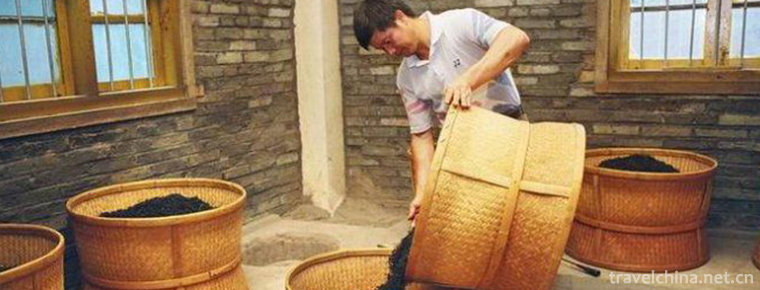
-
Cocotto Sea Scenic Area
The Cocotto Sea Scenic Area and Xinjiang Cocotto Sea National Geological Park, located in Fuyun County, Altay District, northern Xinjiang, covers an area of 788 square kilometers,.
Views: 179 Time 2018-12-12 -
Sannong Expo Park
Shenyang Sannong Expo Park is located in the south of Daliutun Town, Xinmin City, Liaoning Province. It is 15 kilometers away from Xinmin City and 75 kilometers away from Shenyang City. It was built i.
Views: 119 Time 2018-12-18 -
Shanghai Zoo
Shanghai Zoo is located at 2381 Hongqiao Road, Changning District, Shanghai, which is close to Shanghai Hongqiao International Airport. Founded in 1954, originally known as the West Suburb Park. Shang.
Views: 113 Time 2018-12-19 -
Shangrao Lingshan Scenic Area
Shangraolingshan Scenic Area, located in the north of Shangrao County, Shangrao City, Jiangxi Province, is a national scenic spot with an area of 160 square kilometers. Lingshan is listed as the ".
Views: 118 Time 2018-12-19 -
Buyi Chabai Song Festival
The Buyi Chabaige Festival is a commemorative festival of the Buyi people in Xingyi, southwest Guizhou Province. It is held in Chabaichang, Dingxiao Town, Xingyi City.
Views: 152 Time 2019-04-04 -
Daur Ruzhigle Dance
"Luzhigle" is a representative folk dance of Daur nationality. It varies from place to place, including "Alhambo", "Langtudabe", "Hakumai", "Hagen Melger&q.
Views: 103 Time 2019-04-22 -
Silk Strings of Laohekou
Laohekou Silk String is a traditional folk music in Xiangyang City, Hubei Province. Laohekou Silk String is different from other forms of folk literature and art. It is a music that combines folk arti.
Views: 289 Time 2019-05-11 -
Skills of Dry Lacquer and Ramie in Tiantai Mountains
As early as the Eastern Jin Dynasty, dry lacquer and ramie had been used in Tiantai folk. Through the continuous efforts of the substitute craftsmen, their skills gradually matured. In the mid-Tang Dy.
Views: 194 Time 2019-06-21 -
Soil alkali firing technology
On June 7, 2008, the soil-alkali firing system was approved by the State Council and listed in the second batch of national intangible cultural heritage list..
Views: 388 Time 2019-06-23 -
Xiuyan Jade Carving
Xiuyan Jade Carving, one of the national intangible cultural heritage, is a local traditional art in Xiuyan Manchu Autonomous County, Liaoning Province..
Views: 116 Time 2019-07-08 -
Chizhou University
Chizhou college is Anhui Province Full time general Undergraduate Colleges It's the only one in China. Hui Style Architecture The style of colleges and universities is the only one in Anhui colleges a.
Views: 394 Time 2019-11-09 -
Xiling Snow Mountain
Xiling Snow Mountain, located in Dayi County, Chengdu City, Sichuan Province, is only 95 kilometers away from Chengdu, with a total area of 483 square kilometers. It is a world natural heritage, giant panda habitat, AAAA tourist attraction and national key scenic spot..
Views: 321 Time 2020-11-06
